Winter Lawn Prep: The 7-Step Guide
Do you want to prepare your lawn for the winter months but aren’t sure where to start?
It can be tempting to skip autumn lawn care and winter lawn prep, especially as the weather turns and staying indoors feels more appealing. However, investing a little time in your garden now can make all the difference when spring arrives, allowing your lawn to survive the cold, wet weather and keeping it free from moss and diseases.
Here at Online Turf, we have been growing our own premium turf for over two decades and know exactly what it takes to prepare your lawn for winter in the UK. From aeration and overseeding to the final cut before winter, follow our 7-step guide for a healthier, greener lawn once spring rolls back around.
Why Winter Preparation Is Non-Negotiable for UK Turf
Winter lawn prep is non-negotiable if you want to have a beautiful, healthy lawn when spring returns. This is because winter brings several threats to turf in the UK, but a solid lawn maintenance routine can reduce their impact.
The first threat is waterlogging. Since your lawn will have seen a lot of use in summer, it will likely be compacted from all the foot traffic. A compacted lawn will not be able to handle the increasing rainfall and melting snow that winter brings, which leads to waterlogged roots. Waterlogged roots lack oxygen, making grass weak, thin, and more prone to diseases such as fusarium patch and anthracnose.

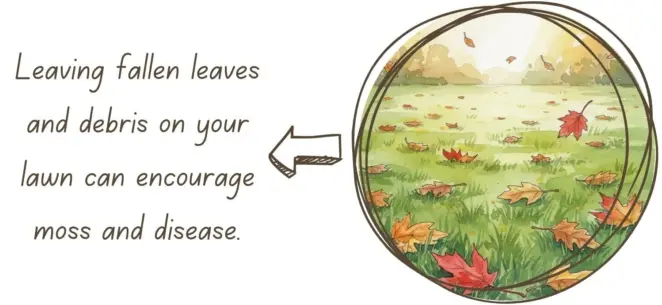
Moss and fungal diseases, like dollar spot and red thread, are another concern. They thrive in wet, humid weather and can develop quickly when debris, such as fallen leaves, are left on the lawn. Check out our ‘Common Lawn Diseases’ blog to learn more.
Poor mowing practices that are unsuitable for the season, such as mowing the grass when it's wet, can weaken the lawn too, causing thinning and patchy or dead areas.
By preparing your lawn for winter in the UK, you’ll protect your grass from these seasonal challenges.
The Autumn Lawn Renovation Window
The period from September to October is crucial for preparing your lawn for winter in the UK. During these months, the soil is still warm enough to support root growth and repair. This makes it the perfect time to scarify, aerate, and overseed your turf.
If you leave these tasks until later in the year, your lawn may struggle to recover before the cold sets in, especially if you live in the northern part of the UK, which tends to experience winter sooner than the south. This can leave it weaker and more vulnerable to winter threats.
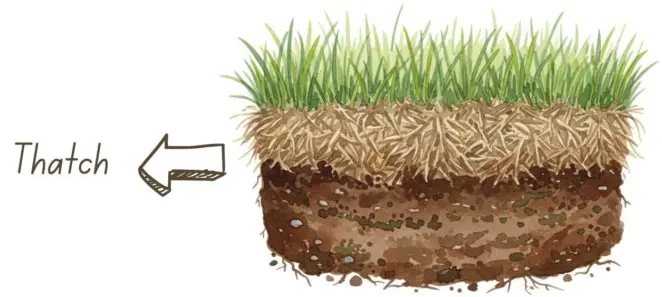
Step 1: Deep Scarifying
Scarification is a lawn maintenance technique used to remove unwanted moss and thatch from well-established lawns. If you have a new lawn, skip this step, as you do not need to scarify it in the first year and doing so can actually damage your turf.
Thatch is a layer of dead grass, moss, and other organic matter that naturally builds up on your lawn over time. A thin layer that does not exceed ½ inch is helpful since it acts as a natural mulch, keeps moisture in, and protects the grass from the cold. However, too much thatch can stop the sunlight, water, and nutrients from reaching the grass roots. This can slow your lawn’s growth and encourage weeds. Thatch can also provide a home for pests and diseases.
Moss, on the other hand, competes with grass for water, nutrients, and sunlight. It spreads quickly and can weaken your lawn.
If your lawn has an excessive amount of thatch, a final scarification before winter will help it in several ways. It will reduce the number of pests and diseases, and allow your grass to take up more nutrients, water, and sunlight. Scarifying first also makes aeration more effective because the soil is no longer blocked by excessive thatch.
Start by applying a moss killer a week or two before you plan to scarify your lawn to make it easier to remove.
Once this time has passed, mow your lawn so that the grass is about 1 inch high and then begin scarifying your lawn.
For a smaller garden, you can use a rake or manual scarifier. Work in rows going up and down your lawn, pushing it a few millimetres into the soil. For larger gardens, a mechanical or electric scarifier is a better option.

Step 2: Aeration to Tackle Compaction
Lawn aeration, which can be done on lawns older than six months, is the process of creating small holes in the ground to loosen compacted soil, often caused by heavy summer traffic. It’s important to do this in autumn as it helps water and nutrients reach the grass roots more easily, strengthening them just in time for the winter. It also improves drainage, allowing it to handle the increased rainfall without becoming waterlogged.
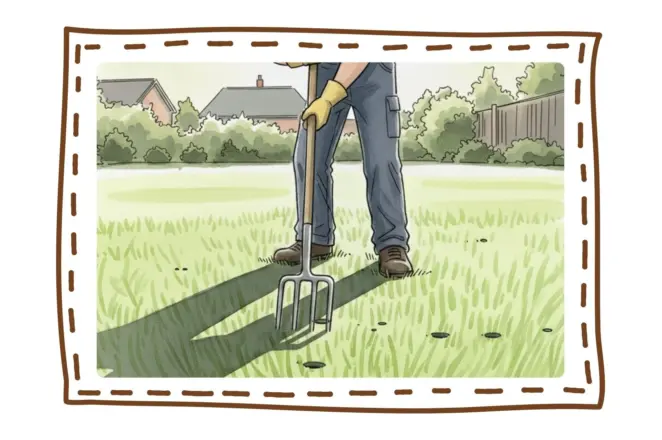
There are two main ways to aerate: spike aeration and plug aeration.
Spike aeration pokes holes in the ground without removing any soil - a good choice for lawns that aren't too compacted.
Plug aeration uses hollow tubes to remove small plugs of soil. These plugs can then be left on the lawn to break down and act as a natural fertiliser, which also helps break down thatch. If your lawn is heavily compacted, choose this option.
For small gardens, you can use a manual spike aerator or a hollow tine aerator. If you don’t have one, a garden fork will do the job. Push it about 4-5 inches into the soil and pull it out so the grass lifts slightly. Repeat this process every 6 inches over the whole lawn. For larger gardens, an electric or mechanical aerator is more efficient. Turn it on, set it according to your soil type and desired depth, then walk slowly across the lawn while it does the job for you.
To learn more about how to scarify and aerate your lawn, read our ‘Lawn Aeration and Scarification: The Ultimate Guide’.
Step 3: Overseeding, Topsoil and Repair
After you have scarified and aerated your lawn, help it recover by overseeding and adding a layer of top dressing.
Overseeding means spreading new grass seed over your existing lawn without removing the old turf. It thickens the grass, making it stronger and more resistant to damage. It also fills in any gaps left by scarification and aeration. The recommended sowing rate for this method is 25 grams per square metre, and should be done using only high-quality, winter-hardy grass seed so that the seedlings can survive the colder months, such as our Rye Gold Lawn Seed. Made from the same high-quality mix of perennial ryegrass and red fescue as our best-selling Rye Gold Turf, it can handle heavy foot traffic and keep its rich, green colour all year round.
Once this is done, spread high-quality topsoil at a rate of 2–3 kilograms per square metre and work it into the aeration holes with the back of a rake. This will help to improve both drainage and the structure of the soil.
You should then water your lawn regularly, unless natural rainfall does it for you, to ensure that the seeds don’t dry out until the lawn is fully established.

The Essential Protective Treatments
Once you have completed the main renovation steps, it’s time for essential protective treatments. These give your lawn the nutrients and strength it needs to survive the cold, damp winter months.

Step 4: Applying an Autumn/Winter Fertiliser
Once all the renovation is complete and your new grass has established, usually after 4-6 weeks, it is time to feed your lawn.
Choose a fertiliser specifically designed for the autumn or winter season and apply it before the ground freezes to allow the roots to absorb the nutrients. For best results, choose a product with high levels of potassium and low levels of nitrogen. Using a feed that’s high in nitrogen this late in the season can cause weak, leggy growth, which is then highly susceptible to frost damage. On the other hand, a feed that’s rich in potassium helps the plant to build stronger cell walls, making it more resistant to frost and disease. It also allows the plant to focus on building a stronger, deeper root system. If possible, choose a feed that includes iron sulphate too. Not only will it provide additional winter turf protection, but it will also improve its colour without encouraging growth.
Step 5: Moss Control
While scarifying and aeration should have removed the moss, you can take extra steps to prevent it from coming back.
Prune any overhanging branches from trees and shrubs that block sunlight from reaching your lawn. The added sunlight will help your grass grow stronger and compete better with moss.
It can be tempting to use moss killers, but wait until your newly established turf is at least six months old before doing so. This is important because the chemicals in these products can harm young, vulnerable grass.
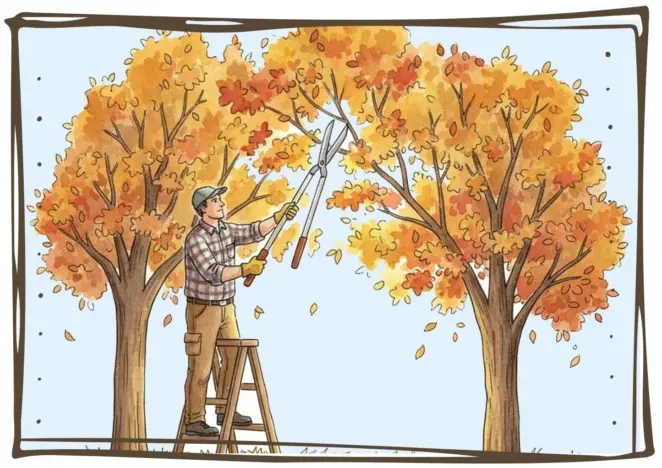
Preparing for Dormancy
As the weather cools and the days get shorter in November and December, your lawn’s growth will begin to slow. Take the necessary steps during this time to ensure it is ready for dormancy.
Step 6: The Final Mow (The Winter Height)
The final mow of the year is one of the most important steps in winter lawn prep. Done correctly, it prevents grass from matting, reduces the risk of pests and diseases, and helps your lawn bounce back quickly when spring arrives.
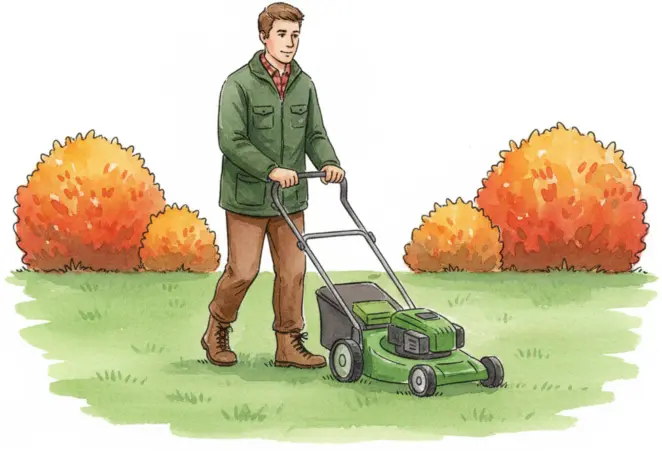
There’s no exact date for the last mow, but it’s usually best done in October or November, once temperatures consistently drop below 7°C, as this is when grass stops growing, and before frost appears. Frozen grass is brittle, and mowing it can fracture the grass blades, which then take a long time to recover in spring.
To achieve the recommended winter grass height on your final mow, set your mower blades to the highest setting. The longer grass blades will help protect your lawn’s roots from the frost and cold temperatures in winter. Then choose a mild, dry day to perform the mow. Avoid mowing a lawn when it's wet if possible, as this is likely to damage the grass blades, weakening them and making your lawn look unkempt and more susceptible to pests and diseases. To learn more about this, read our ‘Can You Cut Wet Grass?’ blog.
You should only start mowing again once the temperatures regularly rise above 7°C and the grass starts actively growing again.
Step 7: Tidy Up and Stay Off
While it may be tempting to leave fallen leaves and debris on your lawn, these can smother your grass, blocking sunlight and air, potentially creating yellow or dead patches. A heavy layer of moist leaves can also encourage fungal diseases, such as dollar spot and red thread, and promote moss growth.
To prevent this, invest in a rake and make sure to remove any debris from your lawn weekly.
You should also avoid walking on your lawn. Colder months in the UK usually bring a lot of rain and occasional snow. Never walk on a wet or frozen lawn, as this can compact the soil and damage grass blades, resulting in breakage and brown patches.
If it’s not possible to avoid walking on your lawn altogether during these conditions, consider using stepping stones to create a path in high-traffic areas and avoid stepping directly on the grass and soil.

Winter lawn prep may feel like a lot of work, but investing a little time in autumn lawn care can make all the difference when spring arrives. By taking care of your lawn now, you give it the best chance to survive cold, wet weather, reducing the risk of pests, diseases, moss, and brown patches.
Are you ready to start? Explore our full range of topsoil and grass seed today to give your lawn the boost it needs before winter!
FAQs
When is the absolute last time I can apply autumn fertiliser?
The absolute last time to apply an autumn fertiliser is before temperatures consistently drop below 7°C, as this is when grass stops growing.
As long as temperatures stay above this, you can still apply fertiliser.
Is it safe to walk on a frosty lawn?
No, you should avoid walking on a frosty lawn. The grass blades are incredibly brittle during this time and walking on them can cause them to snap or break and will leave your lawn with black patches that will only recover in spring.
When should I stop mowing for winter?
This depends on the temperature.
Stop mowing once the grass becomes dormant, usually when temperatures drop below 7°C
Can I leave fallen leaves on the grass over winter?
No, leaving fallen leaves on the grass can smother your grass, block sunlight and air, which can potentially create yellow or dead patches. Damp leaves also create ideal conditions for moss and fungal diseases to thrive because they trap moisture.
Is it better to scarify or aerate in autumn?
It’s best to do both – scarify first, then aerate your lawn.
Scarifying removes excessive thatch, while aeration helps break up compacted soil. When done together, they improve your lawn’s ability to absorb water, air, and nutrients, giving it the best chance to withstand the challenges winter brings.
Online Turf’s Expert Checklist
September
- Deep scarify your lawn - remove excessive thatch and prepare your lawn for aeration and overseeding.
- Aerate the soil - break up compaction to improve water, air, and nutrient uptake.
- Overseed bare patches - use winter-hardy seed like Rye Gold Lawn Seed to allow the lawn to recover.
- Apply top dressing - improve soil structure and drainage.
October
- Apply a specifically designed autumn or winter fertiliser - it should be high in potassium, low in nitrogen, and contain iron sulphate.
- Control moss - prune any overhanging branches from trees and shrubs that block sunlight from reaching your lawn.
- Mow your lawn - perform the final mow of the season. Choose a dry, mild day to do this.
November
- Keep your lawn tidy - Remove any fallen leaves or other debris as it can suffocate your lawn, leading to brown patches and diseases.
Remember: the months listed are a general guide for UK conditions. Adjust the timing of each task according to local weather and temperatures - for example, mild autumn weather may require you to continue mowing until mid-November.


